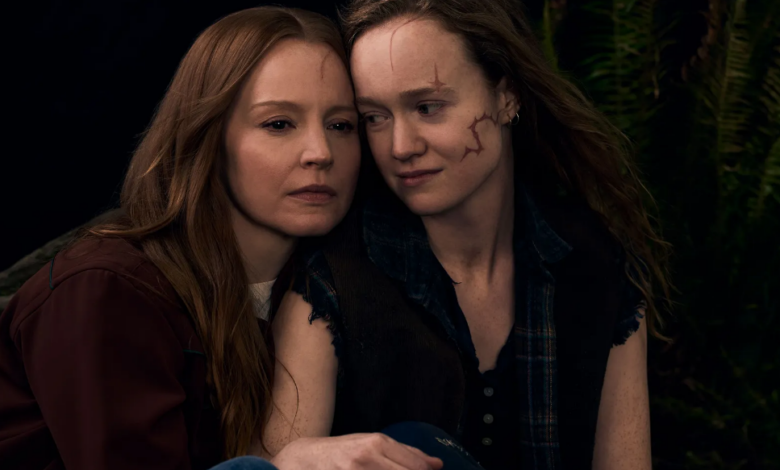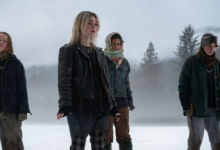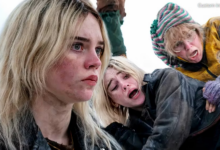Exclusive: Yellowjackets Is Ready to Answer Those Big Questions Now

Yellowjackets cocreator Ashley Lyle takes VF inside the making of season three, teasing everything from a “merging” of the characters’ teen and adult selves to the resolution of several long-standing mysteries: “This season is really when we start bringing those pieces together.”
There’s still not a lot that Yellowjackets cocreator Ashley Lyle can say about the third season of her Emmy-nominated drama series, but she does want to make one thing clear: Answers are coming.
It’s the kind of tease fans are no doubt hoping for as Yellowjackets revs up for its return to Paramount+ with Showtime in early 2025. The gripping series, which weaves between two timelines in its portrait of a group of teenage girls stranded in the wilderness and the aftermath decades later, ended its second season on a string of juicy cliff-hangers. The adult version of Natalie (Juliette Lewis) died at the inadvertent hand of Misty (Christina Ricci), sacrificing herself to save her new friend Lisa (Nicole Maines), while the rest of the women faced an uncertain future after planning to have their estranged peer Lottie (Simone Kessell) committed. The teen version of Natalie (Sophie Thatcher), meanwhile, is named the new leader of the society in the wilderness just as the girls’ cabin is set on fire—forcing them to evacuate, without shelter or a plan.

Coming off of a breakout first season that saw Emmy nominations for best drama and several cast members, Yellowjackets drew a more polarized, if still fervent, response for its sophomore year. The show has now cleared the lanes in both the past and present—with Shauna (Melanie Lynskey), Van (Lauren Ambrose), Taissa (Tawny Cypress), and Misty tenuously reunited—for a fresh start. At the same time, long-standing mysteries regarding what happened in the wilderness, the fates of certain characters, and the lingering question of how (or if) supernatural forces factor into the show’s events may at last be resolved.
Lyle says that season three will realize much of the vision for the show that she and her cocreator, Bart Nickerson, developed at the very outset. This includes the merging of the characters’ teen and adult selves—as shown in these evocative first-look portraits. “Some of it is really character-based; some of it is more literal,” Lyle teases. In each image, clues lurk as to what’s next for our deeply damaged heroes. Below, Lyle digs deep—without giving anything away—on what to expect from season three.

Vanity Fair: Set up season three for us, as best you can. What’s the big-picture idea you went into it with?
Ashley Lyle: When we were initially coming up with the idea for the show, Bart and I would spend hours and hours and hours just coming up with the concept and the characters. The two timelines always felt like the linchpin to the show for us. When we first thought about it, we had specifically latched on to the broad, big concept of the girls’ soccer team, and the survivalism and all of that—but that didn’t quite feel like enough to us. It was when we thought, “What if we did two timelines and we showed the past as present, as something that’s very vital and real and visceral?” That’s what made the show for us.
This season is really when we start bringing those pieces together. That was always the plan. It is very satisfying to have elements of this season that were planned from the very beginning. I cannot get into specifics, I wish I could, but there are a couple of big things in this season that were in the very initial pitches before we even took it out to networks, that we’ve finally got the chance to execute and to play out. The satisfaction of having something in your brains for that long and finally having it come to pass is very exciting.
We’re introducing season three a bit differently here, with portraits that align the two timelines’ versions of the characters. What should we take from them when thinking about where the story is going this season?
For each of these pairings and for each of these characters, the merging, or the overlapping of the past and present, happens in a very different way. It’s very specific to the characters. I have to choose my words so wisely, sorry. [Laughs] In certain cases, that overlap is actually quite literal in a way; in other ones, it is a demonstration of a past and a present character that may have seemed quite different and quite disparate—how that young adult became the person they are. The person that they are, even as an adult, really is an echo or a resonance from the person they used to be.
We love to play with the idea that in some ways, you are who you are. I think back to the person I was when I was 17 years old, and I don’t feel that different. I know I’m different, but in a lot of ways I don’t feel that different. How do you change while you are in your core, in your essence, the same person you always were? How much are you hiding that, and how long are you able to do that, is a question that we’re playing with this season.
Can you talk about Nat a little bit in that context? She does not have an adult counterpart going forward.
There’s an isolation and a heartbreaking loneliness to these photographs. But in thinking about it, and this is maybe going to sound very dark, but that’s all of us, isn’t it? We all have a future self who has died, and we don’t know how that happened and we don’t know why it happened—we don’t know when it’s going to happen. But that doesn’t make who we are now any less vital. In our minds, that is also Natalie’s story. She has a lot of life to live and a lot of story to tell. And the fact that there is a future self that met a tragic end is really the most universal thing that we could probably do on a television show.
In approaching her character this season, we never once thought or had a conversation, “Is it going to affect the way that we write or view Nat’s character?” The answer was just universally, no. We love her character. She has a huge part to play in the 25 years that we haven’t seen. But there’s something really emotionally and philosophically heartbreaking about the position she’s in. It speaks to me of an existential dread that we are all alone, awaiting our fates.
You’ve been open about what it felt like to take in feedback on season one, after it really broke out, before starting on season two. How did you absorb the reaction to season two before starting work on this third season?
Audience feedback is very overwhelming on any front. Whether it is the extremity with which some fans have connected with the show—there are costumes, there are tattoos, there are people who have watched over and over again—or on the other side, of course, there are criticisms, there are expectations, there are people who had an idea of where they wanted things to go and it maybe didn’t go in that direction. That’s natural, and that’s to be expected as well.
Season one was a vacuum. Nobody knows what it is. There are no expectations. Season two was quite overwhelming going into it, knowing now that there were people who had hopes and dreams and expectations for the show. Some people loved it and some people did not like it as much as season one. You really can’t functionally and practically do much of anything with that, because you have to make the show for yourself—for everybody involved—for the actors, for everybody who is pouring their hearts and souls into it.
In a way, season three allowed us to just come back to that a little bit. Even talking to some of the actors at dinner last week, they were saying that they felt really great about this season. In season two, all of a sudden they got up in their heads with the Emmy nominations and what could be. They felt like this season, they were making it for themselves again. That’s how we felt as well. Of course, you hope that people love it, but if you’re trying to make something based on feedback, you’re going to go a little insane, because the feedback is so wildly varied. We just tried to make a show that we loved, and that we felt proud of and that we felt good about.
What can you say about where we find the rest of our leads this season—Shauna, Taissa, Misty, and Van?
We are going to learn more about what happened in the wilderness that they are so afraid of coming out. We hope it will be both satisfying and at times unexpected. And I think that we have found ourselves—let me think of how to say this. [Pause] The stakes are pretty high in the present-day storyline, perhaps in a way that they did not feel in season two, and that was really exciting for us to delve into.
Are there any big, overarching questions that viewers have had over these two seasons, that you feel comes to a clear answer this season?
There are at least two very big questions with very clear answers.




